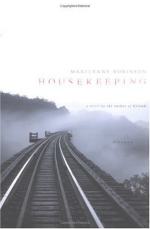|
This section contains 5,498 words (approx. 19 pages at 300 words per page) |

|
SOURCE: Smyth, Jacqui. “Sheltered Vagrancy in Marilynne Robinson's Housekeeping.” Critique 40, no. 3 (spring 1999): 281-91.
In the following essay, Smyth discusses the sociological discovery of female homelessness during the 1980s and contends that Housekeeping reflects a redefinition of the home, wherein traditional domesticity is not merely juxtaposed with vagrancy, but rather shows the home to be a “transient structure” that is neither wholly secure nor permanent.
Departing from a representation of the silent or inarticulate female vagrant as simply projection or scapegoat, Marilynne Robinson creates in Housekeeping an articulate first-person narrator who is also a female drifter. Although the novel begins with Ruth recounting her childhood years under the care of various female relatives—her mother, her grandmother Sylvia, her two great aunts, and finally her Aunt Sylvie—it eventually turns into a story of how she is forced to leave her grandmother's home in Fingerbone, Idaho, to take up...
|
This section contains 5,498 words (approx. 19 pages at 300 words per page) |

|


